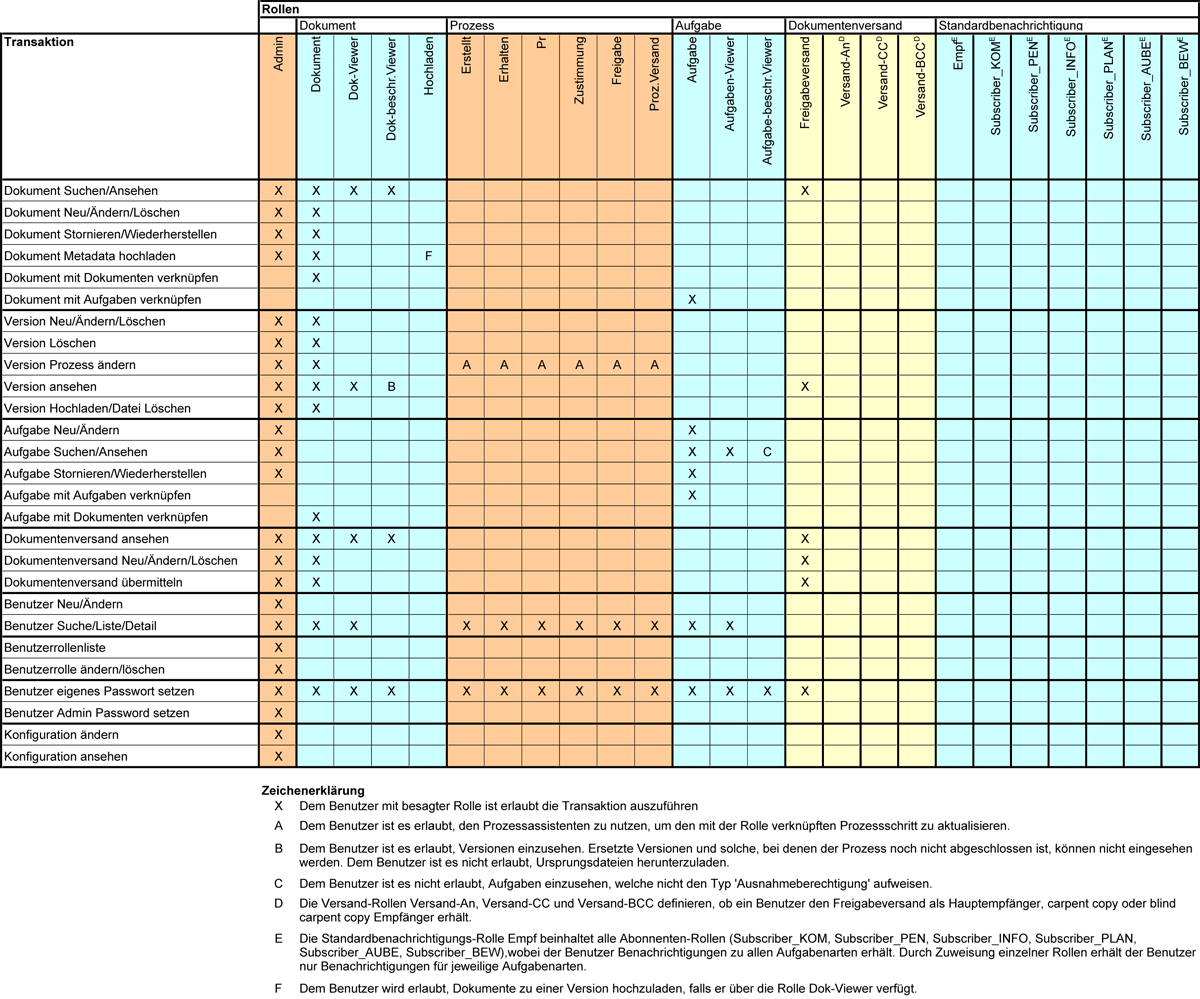Zurück 10. Administration -- Nach Oben Inhaltsverzeichnis-- Weiter A2. Appendix B
User Roles are the mechanism used to control a user’s access to the transactions and data stored in the DrawMGT system. In order to view, enter and update data a user must have the appropriate roles. A user role gives a user the permission to run transactions, e.g. commands initiated by the system menus and screen buttons, on system data, e.g. data stored in folders (Bereiche) and groups (Gruppe). In other words, user roles define permissions, linking users, transactions and system data. Users typically have multiple user roles, which reflect their actual responsibilities on a project. For example, a user may have view roles for some folders and groups, where they merely need access to documents for information purposes, and new/update roles, for areas of the project where they produce documents. In a large project with many users and folders, the number of user roles can get quite large and their management can be a challenge. In many projects, it is critical to ensure that certain documents are protected and are available only to a restricted set of users. DrawMGT provides a convenient reporting mechanism that lets you verify who has access to transactions and system data based on the project area, e.g. folders and groups.
User roles can be assigned at the system, folder or group level. If a role is assigned at the: In all cases, permissions are granted based on the folder/group of the user roles and the folder/group of the data, taking into account user roles at the system and folder level. The algorithm for determining if permission is granted to access data is: Check if the user has the system-level access for the role if if Check if the user has the folder-level access for the role for the folder associated with the data if if Check if the user has the group-level access for the roles for the folder and group associated with the data if if
User role types are divided into classes. The user roles for each class are listed and defined in the following sections.
The Site Administrator user role is assigned to the users that manage the system users and user roles. The following transactions are unique to the Site Administrator role: User create/update User role update User role list User set password – for other users. Note that users are able to reset their own passwords
Note that placing a revision in a submittal automatically makes it accessible to users with the Document Restricted Viewer user role, once the submittal has been transmitted.
The document/revision workflow roles are all associated with performing workflow steps for revisions. The workflow for a revision is a sequence of workflow steps, which must be completed in order. The sequence of workflow steps is: All the workflow steps, with the exception of the submit workflow step, are performed in the revision detail screen. A workflow step role includes the ability to complete and also to update the step, provided that no subsequent workflow steps have been completed. The roles differ only in the workflow step that can be performed: To complete a workflow step, following data must be entered: Für weitere Erklärungen siehe Prozessschritte.
Security Exception tasks can be used to make it possible for users to view revisions that their user roles do not normally allow them to view. See section
Task Subscriber user roles, do not actually define permissions to access and update data, but rather define the default list of users added to a task when it is first created. The list of Task Subscriber user roles is based on the list of task types, with an addition of a Task Subscriber All role. The list of task types depends on the system configuration and is typically different for each project. See section
Note that the Submittal/Transmittal Creator/Updater user role does not allow a user to transmit a submittal. The permission is granted with the Document Submitter user role, described above.
Submittal Recipient user roles, do not actually define permissions to access and update data, but rather define the recipients for submittals. There are three types of submittal recipients: Submittal Primary Recipient (‘To’ recipient) Submittal Copy Recipient (‘CC’ recipient) Submittal Blind Copy Recipient (‘BCC’ recipient) See section A1. User Roles
A1.1 User Role Levels
Systemebene – Berechtigung auf alle Daten im System, inklusive alle Bereiche und Gruppen
yes, grant permission A1.2 User Role Classes

A1.2.1 Administration Roles
Site Administrator – grants permissions for performing all system transactions A1.2.2 Document/Revision Management and Viewing Roles
Document Creator/Updater – Includes the Document View user role permissions, plus: A1.2.3 Document/Revision Workflow Roles
Draft – The draft workflow step only records who drafted the drawing, or typed-in the document. There is no status, plan or complete date recorded for the draft workflow step.
Document Drafter – Permission to perform the drafter workflow step
Plan Date – Optional. The plan date if for informational purposes only. Only users with the Document Creator/Updater role user can change the plan date.
Open – The workflow step has not been completed A1.2.4 Task Management and Viewing Roles
Task Creator/Updater – Includes the Task View user role permissions, plus:
Warning: For security reasons, the Task Restricted Viewer role takes precedence over the other task user roles. This means that if a Task Restricted Viewer role is assigned to a user with the Task Creator/Updater role, then that user will no longer have the permissions to create and update tasks. A1.2.5 Task Subscriber Roles
Task Subscriber All A1.2.6 Submittal Management Role
Submittal/Transmittal Creator/Updater – Permissions for: A1.2.7 Submittal Recipient Roles
Revision 10 as of 2010-08-16 15:41:36
Clear message
